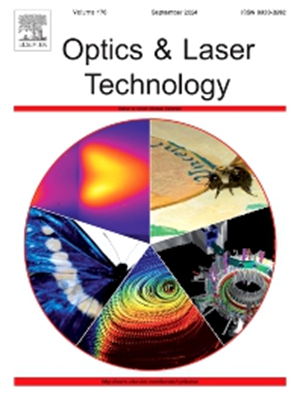CVT growth and optical properties of Cr,Fe:ZnSe single crystals for mid-infrared laser applications
IF 4.6
2区 物理与天体物理
Q1 OPTICS
引用次数: 0
Abstract
At present, the research of transition metal ions doped ZnSe (TM:ZnSe) materials is confronted with the uneven TM-doping and the difficulty of growing high-quality single crystals. In this work, Cr,Fe:ZnSe single crystals with expected elemental doping concentrations were grown at lower temperature by the CVT method using NH4Cl as a transport agent. The UV–VIS–NIR absorption spectrum shows that the concentrations of Cr2+ and Fe2+ ions are 9.61 × 1018 cm−3 and 1.45 × 1019 cm−3, respectively. The element doping efficiency is as high as 96–97 %. Compared with other doping methods, the CVT method can effectively control the doping concentrations of Cr and Fe elements of the as-grown Cr,Fe:ZnSe single crystals, the ratio between which is also very close to the design value. The XPS results demonstrate that the Cr and Fe elements are mainly present as Cr2+ and Fe2+ ions in the Cr,Fe:ZnSe single crystals. The fluorescence spectra under 1770 nm excitation at room temperature show a luminescence peak at about 3400–4900 nm resulting from the energy transfer between Cr2+ and Fe2+ ions. Based on the fluorescence decay lifetime, the energy transfer process can be explained by a non-radiative energy transfer mechanism. The maximum intensity ratio of the luminescence peaks of Fe2+ and Cr2+ ions is about 1:2, and the ratio of the emission peak areas of Fe2+ and Cr2+ ions is 0.852, which indicating that the energy transfer process is more effective. The fluorescence lifetimes of Cr,Fe:ZnSe single crystals at 2200 nm and 4400 nm are 6.3 μs and 6.5 μs, and the emission cross sections are calculated to be 2.02 × 10−18 cm2 and 1.80 × 10−17 cm2, respectively. Therefore, it is believed that the unintentional doping of Cl− ions has no obvious effect on the optical and luminescent properties of the as-grown crystals.

用于中红外激光应用的 Cr,Fe:ZnSe 单晶的 CVT 生长和光学特性
目前,过渡金属离子掺杂ZnSe (TM:ZnSe)材料的研究面临着TM掺杂不均匀和生长高质量单晶的困难。本文以NH4Cl为输运剂,采用CVT法在较低温度下生长出预期元素掺杂浓度的Cr,Fe:ZnSe单晶。紫外-可见-近红外光谱分析表明,Cr2+和Fe2+离子的浓度分别为9.61 × 1018 cm−3和1.45 × 1019 cm−3。元素掺杂效率高达96% ~ 97%。与其他掺杂方法相比,CVT方法可以有效地控制生长的Cr、Fe:ZnSe单晶中Cr、Fe元素的掺杂浓度,两者之比也非常接近设计值。XPS结果表明,Cr、Fe元素主要以Cr2+和Fe2+离子形式存在于Cr,Fe:ZnSe单晶中。室温1770 nm激发下的荧光光谱显示,由于Cr2+和Fe2+离子之间的能量转移,在3400 ~ 4900 nm处有一个发光峰。基于荧光衰减寿命,能量传递过程可以用非辐射能量传递机制来解释。Fe2+和Cr2+离子的最大发光峰强度比约为1:2,Fe2+和Cr2+离子的发射峰面积比为0.852,表明能量传递过程更为有效。Cr,Fe:ZnSe单晶在2200 nm和4400 nm处的荧光寿命分别为6.3 μs和6.5 μs,发射截面分别为2.02 × 10−18 cm2和1.80 × 10−17 cm2。因此,可以认为Cl−离子的无意掺杂对生长晶体的光学和发光性能没有明显的影响。
本文章由计算机程序翻译,如有差异,请以英文原文为准。
求助全文
约1分钟内获得全文
求助全文
来源期刊
CiteScore
8.50
自引率
10.00%
发文量
1060
审稿时长
3.4 months
期刊介绍:
Optics & Laser Technology aims to provide a vehicle for the publication of a broad range of high quality research and review papers in those fields of scientific and engineering research appertaining to the development and application of the technology of optics and lasers. Papers describing original work in these areas are submitted to rigorous refereeing prior to acceptance for publication.
The scope of Optics & Laser Technology encompasses, but is not restricted to, the following areas:
•development in all types of lasers
•developments in optoelectronic devices and photonics
•developments in new photonics and optical concepts
•developments in conventional optics, optical instruments and components
•techniques of optical metrology, including interferometry and optical fibre sensors
•LIDAR and other non-contact optical measurement techniques, including optical methods in heat and fluid flow
•applications of lasers to materials processing, optical NDT display (including holography) and optical communication
•research and development in the field of laser safety including studies of hazards resulting from the applications of lasers (laser safety, hazards of laser fume)
•developments in optical computing and optical information processing
•developments in new optical materials
•developments in new optical characterization methods and techniques
•developments in quantum optics
•developments in light assisted micro and nanofabrication methods and techniques
•developments in nanophotonics and biophotonics
•developments in imaging processing and systems

 求助内容:
求助内容: 应助结果提醒方式:
应助结果提醒方式:


